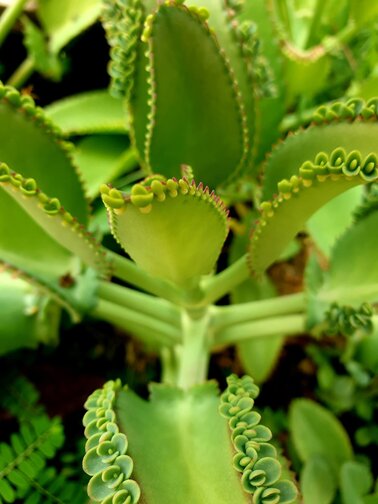Have you encountered an alligator cactus before? What makes this succulent unique is its tiny plantlets growing along the edges of its leaves. The succulent’s distinct look gives its other known name – mother of thousand plants. A single leaf can produce 50 tiny plantlets and the whole plant can make thousands of new alligator plants. Despite this unique and fascinating character, it also carries a negative effect as it makes the plant invasive and displaces other plants.
However, this plant is also commonly known as the alligator cactus because of the tiny plantlets growing on the edges of its leaves that look like an alligator tail. Also, these plantlets develop tiny roots that allow them to survive whenever they fall to the ground. Aside from its common name such as alligator cactus and mother of thousands, this succulent also comes with names like the Devil’s Backbone, Mexican Hat Plant and Evil Genius. The alligator cactus first came from Madagascar but now grows in arid places such as South Africa and South America.
Alligator Cactus Appearance
The alligator cactus has a fleshy green stem like other succulents. A fully mature alligator cactus grows up to 39 inches tall. The leaves are thick and dark green. What makes this plant unique is its tiny plantlets growing at the edge of its leaves. These plantlets acquire roots – the reason why they grow well once dropped on the ground. This uniqueness gives them an illusion of an alligator tail appearance.
The alligator cactus blooms from late December to March. The flowers come in a variety of colors such as pink, purple and red. However, you rarely see this succulent bloom – especially when kept indoors. The flowers come in clusters per branch and protrude from the whole plant.
Caring Needs of Alligator Cactus
Although alligator cactus is easy to grow, its survival depends on what kind of care you give – especially if you have this plant in places far from its natural habitat. To help your alligator cactus thrive, consider the following factors discussed below.
Sunlight Exposure
If you’re growing an alligator cactus indoors, don’t forget to put it outside or on your window for four to six hours in the morning. Since this plant belongs to the family of succulents, it requires sunlight exposure because these plants are already adapted to the arid environment as their natural habitat. Sunlight plays a vital role in their survival. It allows them to produce their food through photosynthesis.
However, sunlight is scarcely available during winter. Don’t worry because you can use artificial lights like LED lights. LED lights imitate the sunlight and give succulents the light they need. These lights come with advantages such as lasting long, energy efficient and you don’t have to worry about your alligator plants getting burned. In using artificial lights as a substitute for sunlight, allow your alligator cactus to bask daily for 13 to 18 hours as this timespan equates to six-hour long exposure to sunlight.
Soil and Pot Requirements
Just like other succulents, the alligator cactus needs well-draining soil and a well-draining pot. When it comes to well-draining soil, four potting mixes are usually used. You can follow the ratio provided below:
- Cactus Mix (2 parts)
- Coarse sand ( 1 part)
- Pumice (1/2 part)
- Perlite (1/2 part)
The above ratio provided is just the basics and you don’t have to strictly follow it. For example, if your alligator cactus experiences slow draining of water, you can put an additional mixture of perlite. One problem that most succulents encounter is root rot due to poor water drainage, so make sure you don’t overlook this factor by using a well-draining soil mixture in a well-draining pot as well.
When to Fertilize Alligator Cactus
You can start fertilizing your alligator cactus in the second year after repotting it. It takes a year for your cactus mix soil to lose its nutrients. However, remember to fertilize your succulent during its active months starting from March to September. Your alligator cactus stays dormant after those months when winter starts. This plant undergoes dormancy to survive the extreme cold and bounces back when the normal temperature starts again.
Fertilizing your alligator cactus during its dormancy period will cause rotting. When succulents hibernate, they stop absorbing the available nutrients provided by the fertilizer. If you put in fertilizer during this phase, it will disrupt their natural growth cycle. Fertilizer will soften their leaves so that they slowly start to rot.
On the other hand, fertilize your alligator cactus during its active season. You may ask – how often? Some people would fertilize this succulent once a month during the summer months. Some say every two to three months and some would say every year. The University of Minnesota Extension suggests fertilizing cacti once or twice a year when they are actively growing.
They also suggest using fertilizers with higher phosphorus content than nitrogen. Diluting the fertilizer in half was the recommended rate.
Water Requirements
If you’re growing alligator cactus indoors, water it once every two weeks. This succulent doesn’t require frequent watering because it can live without water for a long period. Succulents can drink and store water in their leaves and stem through their widespread root system. The reserved water gets tapped when needed.
If your alligator cactus grows outdoors, check the soil by sticking your finger in it. Don’t water it if it feels damp. Give it two days or more, because it varies in the temperature. When the time comes that you need to water it, use water that has a temperature of 68 degrees to 77 degrees Fahrenheit – or simply the same as your room temperature.
However, the best way to water your alligator cactus is the soak and dry method. The soak and dry watering method involves drenching the cactus soil in water and waiting for it to completely dry between watering. What makes this watering method the most recommended one is that succulents develop an extensive root system that allows them to thrive during longer periods of the dry season. The soak and dry method helps your alligator cactus produce larger roots for more water storage.
During the alligator cactus’ dormancy period, give less water. The dormancy period starts during the winter season. As mentioned earlier, succulents like the alligator cactus ingest less water and nutrients when they go dormant so be careful with the amount you give them. It will lead to the rotting of your alligator cactus.
Environmental Requirements
Aside from the light and temperature requirements, growing an alligator cactus requires a safe environment. This succulent contains toxicity that’s dangerous to pets and children. It contains a toxin called bufadienolides that causes paralysis, cardiac poisoning, gastrointestinal distress and even death. Ingestion symptoms include:
- Weakness
- Diarrhea
- Vomiting
Studies show that the alligator cactus possesses toxins for humans instead of potential medical use. Keeping this plant away from kids’ reach is strictly recommended. This succulent possesses a reputation for being a killer of dogs and livestock. It adversely affects the nervous system and muscular systems of animals. If you own pets and livestock at home, it’s best to keep the alligator cactus out of reach.
If you plan to grow alligator cacti outdoors, place them in a pot. Letting this kind of succulent grow on the ground isn’t recommended as it becomes invasive over time. The tiny plantlets easily fall off from their leaves. Putting your alligator cactus in a pot helps prevent this problem because you can catch them and dispose of them properly. Don’t throw the plantlets elsewhere because they multiply faster, displacing other plants from their natural habitat.
Propagating Alligator Cactus
Due to the large number of plantlets found at the edge of its leaves, propagating alligator cactus seems easy. These plantlets already acquire roots while still attached to the leaf holding them. They easily fall off when touched lightly. All you have to do is pick some of the plantlets and place them on a mixture of cactus soil, pumice or perlite (refer to the soil pot requirements mentioned above).
When putting the plantlets on their soil mixture, use a stick to create a shallow hole in the ground. Using a stick makes it easier to adjust the holes that could fit the roots. Remember not to bury the plantlet leaves. The leaves should barely touch the soil. Gently cover the roots with soil and give them enough water.
Ideally, plant them in several pots to make sure you get extra plantlets when others couldn’t make it. If you’re having alligator plants indoors, put them in the brightest corner of your apartment where the sun directly hits them.
Frequently Asked Questions
Should I Remove Babies From Mother of Thousands?
The plantlets naturally drop themselves on the ground so you don’t have to remove them. If you’d like to, you can remove them by gently picking up each baby. They easily detach themselves from the mother leaf.
How Fast Do Alligator Plants Grow?
The tiny plantlet detached from its mother plants takes two to five years to fully grow. It grows up to three feet tall – given that it grows outdoors with the sufficient sunlight it needs. When planted indoors, expect them to grow shorter than three feet.
What Is the Difference Between Mother of Thousands and Mother of Millions?
Mother of thousands grows a single stem that grows upwards following the direction of sunlight. A mother of millions has several stems in contrast to a mother of thousands. Another distinct difference between the two plants is their leaves. A mother of thousands has wider leaves compared to a mother of millions with narrow leaves.
Conclusion
Alligator Cactus is one of the most unique succulents due to its way of reproducing. It’s easy to grow and in fact, an invasive species. Despite its interesting appearance, it’s toxic to both humans and pets. Make sure to keep this plant away from your kids’ and pets’ reach.
If you enjoyed this article, maybe you will enjoy another article we wrote on why your cactus isn’t growing.


1 thought on “Ultimate Guide for Alligator Cactus [Don’t Kill Your Plant]”